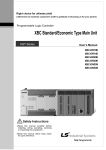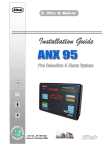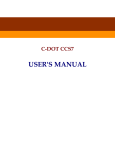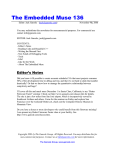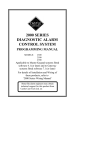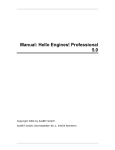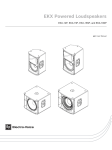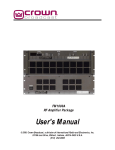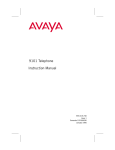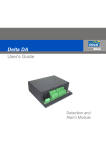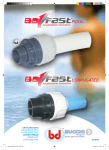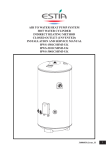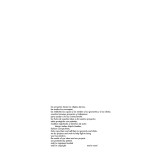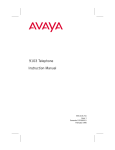Download (KTG 5CHGV[
Transcript
(KTG5CHGV[ $UW1R ,VVXH1RY 1 General Information Information in this document is subject to change without notice and does not represent a commitment on the part of (OWHN)LUH6DIHW\$6 . No part of this document may be reproduced or transmitted in any form or by any means— electronic or mechanical, including photocopying and recording— for any purpose without the explicit written permission of (OWHN)LUH6DIHW\$6 . Copyright ©: (OWHN)LUH6DIHW\$6, Norway 2000 NS-ISO 9001 Certificate No. 244 & 319 The certificate does not cover manufactured products. Please, contact our Main Office at following addresses: (OWHN)LUH6DIHW\$6 P.O. Box 3514 N-3007 DRAMMEN Norway Phone: Fax: E-Mail (Product Dept.): E-Mail (all departments): 47 32 24 48 00 47 32 24 48 01 [email protected] [email protected] Visit our Web site on the Internet at: Home page: www.eltek-fs.no Technical Personnel Area: Click on the 7HFK=RQHbutton $UW1R ,VVXH1RY 3XEOLVKHG This document was produced using 06:RUG mfm2000.11.14_1201043.doc_B4 $1; Varticle number is 242850.001 2 Technical Specification $1; Art. No. 351201.043, v2-112000 1 General Information &RQWHQWV *HQHUDO,QIRUPDWLRQ *HQHUDO,QIRUPDWLRQ3DQHO Alarm monitoring:.............................................................................................. 5 Fault monitoring: ............................................................................................... 5 Function:............................................................................................................. 5 Activation ............................................................................................................ 5 )URQW3DQHO )URQWFDUG(3 )URQW/D\RXW 'LVSOD\ .H\6ZLWFK &RQWURO3RZHU%RDUG 3URFHVVRU6\VWHP SOFTWARE ...................................................................................................... 9 RAM: ................................................................................................................... 9 EEPROM:........................................................................................................... 9 1) Panel set-up .................................................................................................. 9 2) Customer text................................................................................................ 9 3) Sectioning of sounders/alarm outputs ...................................................... 9 4) Detector-limits/values ................................................................................ 10 5) Multi-function............................................................................................... 10 3URJUDPPDEOH&LUFXLWV 3.2.1 Analogue (ANX) detector loop with return, for circuits 01-02......................... 11 Equipment: ....................................................................................................... 11 Configuration: .................................................................................................. 11 Information: ...................................................................................................... 11 Loop limitation: ................................................................................................ 11 Limitations within the loop: ............................................................................ 12 Program possibilities: ..................................................................................... 12 3.2.2 Analogue (ANX) detector loop without return, for circuits 01-02 .................... 12 Equipment: ....................................................................................................... 12 Configuration: .................................................................................................. 12 Information: ...................................................................................................... 12 3.2.3 Conventional (ZLX) detector loop, for circuits 01-08 ..................................... 13 Equipment: ....................................................................................................... 13 Configuration: .................................................................................................. 13 Information: ...................................................................................................... 13 Loop limitation: ................................................................................................ 13 3.2.4 Sounder circuits, for circuits 03-08 ................................................................ 13 Equipment: ....................................................................................................... 13 Configuration: .................................................................................................. 13 Programming possibilities:............................................................................. 14 3.2.5 Alarm outputs for circuits 01-08..................................................................... 14 Equipment: ....................................................................................................... 14 Configuration: .................................................................................................. 14 Selection possibilities: type of alarm output:............................................... 14 Programming possibilities:............................................................................. 14 3.2.6 I/O units, for analogue detector loops ........................................................... 14 Equipment: ....................................................................................................... 14 Programming possibilities:............................................................................. 15 Power consumption: ....................................................................................... 15 Technical Specification $1; Art. No. 351201.043, v2-112000 3 1 General Information $GGLWLRQDO)XQFWLRQV 3.3.1 Fireman’s Access / L.B.A............................................................................... 16 3.3.2 Communication channels .............................................................................. 16 3RZHU6XSSO\ Power supply / output:.................................................................................... 17 Power/battery function: .................................................................................. 17 'HWHFWLRQ6HFWLRQ 'HWHFWLRQ6HFWLRQIRU$QDORJXH'HWHFWRUV General: ............................................................................................................ 18 Adjustment of alarm limits: ............................................................................ 18 Addressing: ...................................................................................................... 18 Treatment of detector data:........................................................................... 19 Various types of detectors: ............................................................................ 19 'HWHFWLRQ6HFWLRQIRU&RQYHQWLRQDO'HWHFWRUV Various types of detectors: ............................................................................ 19 =RQH0RQLWRULQJ8QLW Limitations: ....................................................................................................... 20 3DQHO)XQFWLRQV 3DQHO1RUPDO2SHUDWLRQ Monitoring functions: ...................................................................................... 21 Isolation warning by means of key switch function.................................... 21 3UHDODUP )LUH$ODUP0RGH Alarm ................................................................................................................. 22 Automatic isolation during fire alarm............................................................ 23 )DXOW0RGH Monitoring functions: ...................................................................................... 23 Fault mode: ...................................................................................................... 24 6.4.1 Fault in detector loop ..................................................................................... 24 6.4.2 Detector Fault ................................................................................................ 24 6.4.3 Sounder Circuit Fault ..................................................................................... 25 6.4.4 Battery Fault .................................................................................................. 25 6.4.5 System Fault.................................................................................................. 25 6.4.6 Communication Fault - RS485....................................................................... 25 6.4.7 Mains Power Fault ......................................................................................... 25 6.4.8 Earth Fault..................................................................................................... 26 (OHFWULFDO6SHFLILFDWLRQV Detector loops - Analogue version .................................................................... 27 Detector loops - Conventional version .............................................................. 27 Sounders ............................................................................................................ 27 Alarm output ...................................................................................................... 27 Storage capacity - EE-prom memory................................................................. 27 Power consumption ........................................................................................... 28 24V DC circuit................................................................................................... 28 Charger .............................................................................................................. 28 Battery................................................................................................................ 28 Communication.................................................................................................. 28 4 Technical Specification $1; Art. No. 351201.043, v2-112000 1 General Information *HQHUDO,QIRUPDWLRQ This manual "Technical specifications", together with additional equipment documentation, provides the necessary information for operation of the panels internal and external functions. "Technical specifications" is a part of the user manual for fire warning panel ANX95. The user manual has the following main sections: • • • Operation instructions Technical specifications Installation guidance. *HQHUDO,QIRUPDWLRQ3DQHO Fire guide ANX95 is an intelligent microprocessor based fire alarm panel. ANX95 monitors and controls all the functions that the equipment consists of and at the same time forms a communication unit for the user. The panel has the following important functions: Alarm monitoring: ANX95 monitors the protector areas for smoke, fire and temperature development. Fault monitoring: ANX95 has a continual monitoring of faults in the panel’s internal and external functions. Examples of fault reports are detector faults, circuit faults, sounder circuit faults, communication breakdown, power failure, battery faults, system faults etc. Function: The ANX95 continually receives signals/reports from the whole system. The signals are continually interpreted and responded to. If the signals/reports have values outside of the normal values, the panel will immediately carry out the instructions specified in the program. Activation If a report is received where a response from the panel is required, the ANX95 will activate the functions in accordance with instructions, which are provided in the software. Normally this means activation of sounders, control circuits alarm/fault lamps, buzzer and display. Sounders and control circuits can be specially programmed in accordance with customer wishes. Technical Specification $1; Art. No. 351201.043, v2-112000 5 2 Front Panel )URQW3DQHO The fireguard ANX95 consists of the following two main units: • • Front panel Control /power card EP770 The front panel is the user’s interface to the system. From here all reports will be shown in plain text. The panel can be operated with the aid of a keyboard and it is from here that buzzers and warning lamps for the various reports will be activated. The front panel consists of the following units: • • Front board EP773 Operation panel ß Front layout ß Display ß Key switch )URQWFDUG(3 The front card EP773 is equipped with the following units: 1. Buzzer (BZ1) 2. Lamps -Indicator diodes for fire (LED1-3) -Indicator diodes for multiple alarms (LED4-5) -Indicator diode for extinguisher equipment, activated (LED7) -Indicator diode for fire ventilation, activated (LED6) -Indicator diode for customer specified function, activated (LED8) -Indicator diode for alarm sender, activated (LED13) -Indicator diode for alarm location, disconnected (LED12) -Power diode (LED11) -Fault diode (LED10) -Disconnection diode (LED9) 3. Connection sockets for: -Buzzer (PL6) -Display (backlight PL2) -Key switch (PL3) -Layout keys (PL4) -External keys for multi function (PL5) 4. Options: - Jumpers J1 and J2 are installed as a standard. However, if EP773 is not equipped with LED9-LED11, only J3 shall be installed. This means that LED6 will be used as a fault indicator diode. NB: This is a special provision and not normally used. Ref. fig. 2.1.1 Front board EP773 6 Technical Specification $1; Art. No. 351201.043, v2-112000 2 Front Panel )URQW/D\RXW The front layout consists of the following: 1. Explanatory function text. 2. Various windows for LED and display 3. Keyboard: -operating keys 0-9, * and MENU -key for sounder silencing -key for alarm silencing -key for showing alarm sequence under multiple alarms. 'LVSOD\ 0DLQ0HQX $1; 5(6(7 7(67 ,62/$7,215(&211(&7 6<67(0,1)250$7,21 Fig. 2.3.1 Display All information concerning the status of the fire alarm system together with the operation menus are shown in plain text on the alphanumeric display. The display consists of two lines with 40 characters in each. See for example fig. 2.3.1 Display. NB: The display contrast can be adjusted with the help of the operation menu. .H\6ZLWFK The ANX95 keyboard is usually locked so that unwanted access is avoided, i.e. the key is usually in the locked or open position. To use the keyboard the key must be turned clockwise to the "OPERATE" position. Fig 2.1.1 When the position of the key is changed the display will confirm the keyboard status for about 5 seconds. Status for position "locked/open" &/26(')2523(5$7,21 Status for position "operation" 23(1)2523(5$7,21 Technical Specification $1; Art. No. 351201.043, v2-112000 7 3 Control / Power Board &RQWURO3RZHU%RDUG The fireguard ANX95 consists of the following two main units: • Front panel • Control/power board EP770 The control/power board is the main unit in the system, and it is here that the loops/circuits, battery, mains are connected and the software located. The control/power board EP770 consists of the following main parts: 1. Processor system 2. Definable circuits 3. Various functions 4.Power section 8 Technical Specification $1; Art. No. 351201.043, v2-112000 3 Control / Power Board 3URFHVVRU6\VWHP The controller 80C537 is a Siemens controller with 12 a/d inputs, 21 PWM outputs, an integrated watch-dog, 2 uarts, 4 x 16 bit timers, 14 interrupt sources and a series of I/O-lines. NB: All data and address lines are separated from the internal lines with buffers/filters, so as to avoid unnecessary radiated interference and to protect the internal data bus. SOFTWARE E-prom: Type: 27C010 (1 megabit = 128 Kbyte). The standard program for controlling all ANX95 functions is located here. RAM: Type: 71C256 (256 Kbit = 32 Kbyte) EEPROM: Type: 28C64 (64 Kbit = 8 Kbytes). The EEPROM provides the following possibilities: 1. Programming of panel setup. 2. Programming of customer specified text. 3. Programming of sectioned sounder/alarm outputs. 4. Programming of detector values/limits. 5. Programming of multi-function. NB: Programming of items 1-4 are normally done by ELTEK Service. 1) Panel set-up Definition of the panel set-up is done via the set-up menu. The values that are changed in the set-up menu will be stored in the EE-prom. ELTEK Service normally does this. NB: Stored values in the EE-prom will not be changed even if the panel is without power. 2) Customer text Customer specified text provides the possibility for plain text display of fault reports and fire alarms. Amendment of customer texts that are already written into the EE-prom can also be carried out. The EE-prom can be programmed with up to 90 texts. 3) Sectioning of sounders/alarm outputs All sounder/alarm outputs can be programmed so that they can be activated from any specific detector/group of detectors during an alarm. The EE-prom can be programmed with up to 100 different groups of detectors/detector groups (sections). Technical Specification $1; Art. No. 351201.043, v2-112000 9 3 Control / Power Board Up to 8 I/O-units per analogue detector loop can be defined. Each I/O-unit can be equipped with 1-3 alarm outputs which provide a maximum of 48 alarm outputs divided between two analogue detector loops. The number of sounders/alarm outputs on the terminal block will depend upon the number of circuits that are defined in the set-up of the panel. 4) Detector-limits/values Provision is made for programming customer specified detector limits for alarms and prealarms. The EE-prom can be programmed with up to 200 limit values. 5) Multi-function Provision is made for programming 7 multi-functions. The multi-functions are activated either by pressing a key (3 off) on the keyboard or external keys (4 off). 3URJUDPPDEOH&LUFXLWV The ANX95 is equipped with 8 circuits. These circuits are programmable for different types of functions. Amongst others the causes can be defined for detector loops (analogue, conventional), sounder circuits and/or alarm output. The functions can be altered according to type and number. When this is specified we have a defined panel set-up. Each set-up of the panel requires the definition of dedicated software with a related configuration of circuits. This is done by means of jumpers/shunts that are located on the control/power board. The location of the jumpers is indicated on the terminal block drawing for the panel in question. A standard panel set-up and configuration for ANX95 that is delivered from (OWHN)LUH6DIHW\$6 is shown on the accompanying terminal block drawing. If the panel set-up is to be amended to accommodate a customer specified version, then special software is to be used. Contact the (OWHN)LUH6DIHW\$6 service department for additional information. 10 Technical Specification $1; Art. No. 351201.043, v2-112000 3 Control / Power Board The circuits can be defined with the following functions in the panel set-up: 1. Analogue (ANX) detector loop with return 2. Analogue (ANX) detector loop without return 3. Conventional (ZLX) loop 4. Sounder-live circuit 5. Alarm output control circuit 6. I/O units. $QDORJXH$1;GHWHFWRUORRSZLWKUHWXUQ IRUFLUFXLWV Equipment: ANX95 can be equipped with up to 2 off analogue detector loops in the panel set-up. These can only be defined for circuits 01-02. The position on the terminal block (TB01-TB02) is automatically selected when the appropriate circuit is defined. NB: The sum total of the choice of detector loops sounder circuits and control circuits cannot exceed 8. Configuration: If the set-up of the panel is amended because of the selection of number or type of loops/circuits, then configuration of jumpers (J1-J31) must be carried out. Information: ANX95 handles all the data relating to double addressing, faults, prealarm and alarm limits for the detectors. In addition it will also control the connection/isolation of detectors and loop from the panel. Each detector is continually "polled" by ANX95 about its analogue value. The panel will then compare the analogue value of the detector with the specified alarm limits, and will then decided if the detector is reporting normally, giving a warning or reporting fire or faults. Each detector is normally polled every 10 seconds. If the analogue value exceeds the specified limit value the polling cycle time for the detector in question will be reduced to 1.5 seconds. When the system is reset, the ANX95 "scans" the detector loops and collects data concerning the detector type, analogue value and number of detectors. The number of detectors is compared with the number in the programmed setup. Any difference between the registered number and the program number will be reported as a system fault. Should a detector loop be damaged, no detectors will be without power because power is supplied from both sides (ring main). Loop limitation: The ANX95 can be equipped with a maximum of 2 analogue detector loops. Technical Specification $1; Art. No. 351201.043, v2-112000 11 3 Control / Power Board Limitations within the loop: - Max. 99 detector addresses per loop. - Max. 8 I/O units per loop - Max. 10 units per loop - Zone monitoring unit Program possibilities: - Number of detectors in the loops. - Number of I/O-units in the loops. - Alarm limit values - Customer specified text. If I/O-units are to be used, the number of I/O-units and addresses in the set-up menu is to be programmed. $QDORJXH$1;GHWHFWRUORRSZLWKRXWUHWXUQ IRUFLUFXLWV Equipment: The ANX can be equipped with up to 2 analogue detector loops without return in the panel set-up. These can only be defined for circuits 01-02. NB: For circuits 01-02, a sectionable alarm output (unloaded) will automatically be available in addition to this detector loop. The position on the terminal block (TB01-TB02) will be automatically selected when the appropriate circuit is defined. NB: Note that the detector loop with return is the same as the detector loop without return, but with the exclusion of the return loop. NB: The sum total of the choice of detector loops, sounder circuits and control circuits cannot exceed 8. Configuration: If the set-up of the panel is amended because of the selection of number or type of loops/circuits, then configuration of jumpers (J1-J31) must be carried out. Information: By excluding the return feed voltage for the detector loop (as mentioned above) an analogue loop without return will have been created. The same conditions mentioned in the former item apply for this type of detector loop. The only difference is that the return loop cannot be used. A break in the loop will mean that only those detectors that are installed between the panel and the break will remain operative. However, the break will be registered by the ANX95, since it will no longer receive a response from the "dead" detectors. 12 Technical Specification $1; Art. No. 351201.043, v2-112000 3 Control / Power Board &RQYHQWLRQDO=/;GHWHFWRUORRSIRUFLUFXLWV Equipment: The ANX can be equipped with up to 8 detector loops in the panel set-up. These can only be defined for circuits 01-08. For circuits 01-02, a sectionable control circuit (unloaded) will automatically be available in addition to this detector loop. The position on the terminal block (TB01-TB08) will be automatically selected when the appropriate circuit is defined. The sum total of the choice of detector loops sounder circuits and control circuits cannot exceed 8. Configuration: If the set-up of the panel is amended because of the selection of number or type of loops/circuits, then configuration of jumpers (J1-J31) must be carried out. Information: ANX95 handles all the data relating to faults and alarms for the detector loops. In addition it will also control the connection/isolation of loops from the panel. Each detector loop is continually "asked" by ANX95 about its status. The panel will then compare the values in the detector loop with the specified alarm limits, and will then decide if a fire or fault is being reported. The cycle time for reviewing the detector loop is normally 10 seconds depending upon the number of detectors. If a detector in the detector loop is removed the panel will register a break. Loop limitation: The ANX95 can be equipped with max. 8 conventional (ZLX) detector loops. NB: Because of the monitoring function a terminal resistance must be connected to the end of the loop. 6RXQGHUFLUFXLWVIRUFLUFXLWV Equipment: The ANX can be equipped with up to 6 sounder circuits. These can only be defined for circuits 03-08. The position on the terminal block (TB03-TB08) will be automatically selected when the appropriate circuit is defined. The sounder circuit for circuit 08 is specially designed for use in the fault function. Note that the choice of detector loops sounder circuits and control circuits cannot exceed 8. Configuration: If the set-up of the panel is amended because of the selection of number or type of loops/circuits, then configuration of jumpers (J1-J31) must be carried out. Technical Specification $1; Art. No. 351201.043, v2-112000 13 3 Control / Power Board Programming possibilities: The sounder circuits can be individually sectioned as required. The sounder circuits are monitored for breaks and short circuits. Because of the monitoring function a terminating resistor must be connected to the end of the loop. $ODUPRXWSXWVIRUFLUFXLWV Equipment: The ANX can be equipped with up to 8 alarm outputs in the panel set-up. 6 control circuits (NC, C, NO) can be defined for circuits 03-08, while 2 off control circuits (no) will automatically be defined when ANX loop without return or ZLX loop is selected for circuit 01-02. The position on the terminal block (TB01-TB08) will be automatically selected when the appropriate circuit is defined. Note that the choice of detector loops sounder circuits and control circuits cannot exceed 8. Configuration: If the set-up of the panel is amended because of the selection of number or type of loops/circuits, then configuration of jumpers (J1-J31) must be carried out. Selection possibilities: type of alarm output: Alarm outputs that can be defined for circuits 03-08 are full value alarm output alternating contacts (NC, C, NO). Control circuit 08 is specially designed for use in the fault function. The alarm outputs defined for circuits 01-02 are not full value alarm output control contacts since they are only connected for NC, C. Programming possibilities: The control circuits can be individually sectioned as required. Under normal circumstances the control circuits in the panel will not be in the active mode. Exception: If a control circuit is defined as a door magnet circuit (alarm 3) this will be active as a part of the normal status of the panel. If main power drops out the door magnet circuit will be deactivated after about 15 minutes. This is done to increase the operational time of the panel when powered by battery. ,2XQLWVIRUDQDORJXHGHWHFWRUORRSV * Only for analogue detector loop * Equipment: The ANX95 can be equipped with up to 8 I/O-units per analogue detector loop in the panel set-up. When each of the 8 I/O-units is equipped with 1-3 alarm/sounder outputs this will give a total of max. 24 alarm/sounder outputs for each analogue loop. The address of each I/O-unit (100-107) must be defined for each unit and each loop. Selection possibilities; type of control circuit: On each I/O-unit it is possible to select either an alarm output control circuit or a live sounder circuit. 14 Technical Specification $1; Art. No. 351201.043, v2-112000 3 Control / Power Board Programming possibilities: The alarm/sounder outputs can be individually sectioned. Power for activating the I/O units relays and control functions must be obtained from a separate 24VDC auxiliary source and not from the detector loop. Power consumption: Approx. 1mA (normal operation), power consumption from detector loop approx. 30mA per relay in activated mode, power from 24VDC. Technical Specification $1; Art. No. 351201.043, v2-112000 15 3 Control / Power Board $GGLWLRQDO)XQFWLRQV )LUHPDQ V$FFHVV/%$ The ANX95 is equipped with an access on the terminal block (TB12) for activation of the following functions: • • • • • Extinguisher system activated *) Fire ventilation activated *) Customer specified system activated *) Received message, fire department *) L.B.A./General alarm **) *) When a function is activated a light diode on the front panel will be lit and the display text will show which system activated the input. **) If the L.B.A. general alarm function is activated the sounder circuits will be activated with a rapid signal. L.B.A. and fireman access on the panel is activated by first selecting a function by means of the operation menu and then connecting the resistance value on the terminal block TB12A/B. Each resistance value represents each function. NB: Circuit 12 can be monitored with the aid of the terminal resistance (option). See fig. 3.3.1 for connection of resistance values. &RPPXQLFDWLRQFKDQQHOV The ANX95 can communicate with other external units e.g.: • Other panels or operation panels • Printer/PC • Bleepers The serial gates Com1 and Com2 can be used for communication with other units. The gates can be defined for 2 off RS232 or 2 off RS485 interfaces. Check in the menu set-up that the Com-gates Com1/Com2 are configured with the equipment that is to be connected. RS485 is fault monitored and can both send and receive out and return data. RS232 and RS485 have a data transfer speed that can be programmed in the software from 2400 to 19200 baud. The communication circuits are protected from overloading and interference from the line. The normal baud rate for RS485 is 4800. This allows a communication line of a length up to about 1000 metres. A communication cable up to about 15 metres can be used for RS232. 16 Technical Specification $1; Art. No. 351201.043, v2-112000 4 Power Supply 3RZHU6XSSO\ ANX95 is designed for a mains operation (230VAC) and a 24V-battery back up. Power supply / output: Effect: 75W Input voltage: 230VAC Output voltage: 27VDC/3A *) *) The output power is used for: 1. Charging voltage: 27.2V 2. Output for 24VDC (auxiliary voltage) 27.2V 3. Internal + 5VDC. The software governs the output voltage reference. Power/battery function: 1. If the battery voltage is low or a short circuit occurs, the charging voltage to the battery will be limited so that the power is not overloaded. 2. Every 20 seconds the charging voltage is switched off so that the panel can check that the battery fuses are intact. 3. Every fourth hour the battery is loaded with approx. 0.7 Amps. so as to check the battery. While the battery is loaded (approx. 10 seconds) the charger will be switched off. A battery fault will be reported if the battery voltage is less than 24V. Technical Specification $1; Art. No. 351201.043, v2-112000 17 5 Detection Section 'HWHFWLRQ6HFWLRQ 'HWHFWLRQ6HFWLRQIRU$QDORJXH'HWHFWRUV General: Apollo has developed a series of fire detectors that continually report the status of the area, which is under protection. ANX95 uses Apollo analogue detectors, which employ digital signal techniques providing high reliability and allowing many detectors to be connected. If smoke or heat is developed the Apollo detectors will transform the analogue signals to digital values that will be sent back to the panel along the same leads that deliver power to the unit. 99 address units can be connected to a loop and detailed information from all units only requires less than 4 seconds. A special interrupt system provides a response time of less than 2 seconds from manual call point unit. Adjustment of alarm limits: The system allows alarm and pre alarm levels for each detector to be adjusted. This is programmed from the panel. For each address unit the panel has the possibility of turning on light diodes, testing detectors and operating outputs for remote control/ remote LED. The method of sending and receiving data has been developed so as to provide high communication reliability and a high immunity from interference even when long cables are used. Addressing: Each detector is given its own 7-bits address. The panel continually "asks" each detector to send its address in the form of digital pulse position modulation. Each detector "responds" with a sequence of power pulses that contain the following information: • The detectors analogue value • Confirmation of the last programming (e.g. light diode switched on) • Type of detector: - IO (ion detector) OD (optical detector) VD (heat sensitive detector) MM (manual call point unit) AS (aspiration detector) BI (zone monitoring unit). • Confirmation of correct address. The method allows the collection of information from 32 to 56 detectors per second. Using the quickest method only, analogue values will be returned. The address units can be called up in any sequence and one address can therefore be called up more often than others, with analogue values over or under the defined limits. 18 Technical Specification $1; Art. No. 351201.043, v2-112000 5 Detection Section Treatment of detector data: In the panel the detector analogue values are compared with the preset limits, NORMAL, PREALARM, ALARM and FAULT. If the analogue value, after several "requests", continues to be above the preset limit of e.g. prealarm, the panel will give an alarm. This means that the panel via an internal buzzer and display will indicate that the smoke concentration in the zone has exceeded the preset level. The main alarm, sounders and alarm outputs will remain passive. If the analogue value of the detector continues to rise to the alarm level and remains there over a preset time of approx. 10 seconds, the panel will record a fire alarm. Alarm 1, sounders and all specified control functions connected to the alarm will be activated. The display on the panel will continually indicate which status the panel is in and which decisions have been taken. Various types of detectors: Ion-detectors, optical detectors, heat detectors, flame detectors, aspiration detectors and line detectors (activated by visible smoke). 'HWHFWLRQ6HFWLRQIRU&RQYHQWLRQDO'HWHFWRUV Apollo has developed a series of 5 detectors that continually report the status of the area under protection. In the event of smoke or heat development the conventional detectors will give a fire warning by means of preset power levels that are sent back to the panel via the same leads that deliver power to the unit. ANX with conventional loops can distinguish between manual call point unit (with 680 ohm) and other types of detectors. Even with the loop isolated it will still be possible to receive fire alarms from manual call point units (with 680 ohms) while all the other detectors are disconnected. NB: The detector loop will not be without power when isolated. If several detectors in the same loop give simultaneous fire alarms, the panel will register each of these alarms as a separate alarm. The detector loop is monitored by means of a terminal resistance mounted in the final socket/detector in each loop. In any single loop 32 detectors can be connected. Various types of detectors: Ion-detectors, optical detectors, heat detectors, flame detectors and line detectors (activated by visible smoke). Technical Specification $1; Art. No. 351201.043, v2-112000 19 5 Detection Section =RQH0RQLWRULQJ8QLW * Only for analogue detector loop * If branching from an analogue detector loop is necessary, this can be done by means of a zone monitoring unit. The zone monitoring unit is connected to the analogue detector loop as a detector and shall be addressed as such. The zone monitoring unit is a conventional detector loop and therefore the detectors in this loop can also be of the conventional type. The zone monitoring unit has an address, which is common for the conventional detectors that are connected to the zone-monitoring unit. Limitations: - Max. 10 zone monitoring units per analogue detector loop - Max. 10 detectors per zone monitoring unit. NB: Because of the monitoring function panel resistances must be mounted on the end of the zone-monitoring unit (final detector). Power consumption is approx. 5mA per zone monitoring unit. 20 Technical Specification $1; Art. No. 351201.043, v2-112000 6 Panel Functions 3DQHO)XQFWLRQV 3DQHO1RUPDO2SHUDWLRQ As long as there exists no fault reports, pre-warning or fire alarms the ANX95 will be in the normal operation mode. In this mode — with key in closed position — the following can be observed: 1. Mains power diode lit (Green LED). No other diodes shall be activated as long as the isolation function and the fireman access is not activated. 2. The display will confirm in plain text that the panel is in the normal operation mode. Monitoring functions: The ANX95 monitors continually the panel's internal and external functions for faults. ANX95 monitors the following functions: - Detector and detector loops (fault, prealarm, alarm, break, and short circuit) - Sounder circuits (break, short circuit) - High/low battery voltage - Micro processor software - Microprocessor with associated circuits - Communication - Mains power supply - Internal power supply - Earth fault. Isolation warning by means of key switch function The key switch/buzzer has the following warning function during isolation. 1. If an alarm output is disconnected while the key switch is in the "OPERATION" position and then is switched to closed position the internal buzzer will be activated with a continual signal. 2. If certain functions are disconnected while the key switch is in the "OPERATION" position and is then switched to closed position the internal buzzer will be activated with a continual signal for about 2 seconds. In both cases the internal buzzer warns the user that certain functions are isolated. Technical Specification $1; Art. No. 351201.043, v2-112000 21 6 Panel Functions 3UHDODUP * Only for analogue detector loop * When the analogue value of one or more detectors reaches the prealarm limit, the internal buzzer will be activated and the fault diode lit. The panel keyboard is activated by means of the fireman’s key. When the key is turned clockwise to the "OPERATION" position the internal buzzer will be silenced. The display will indicate which detector has given the prealarm. If several detectors have given prealarms the loop and detector numbers will be scrolled on the display. The two digits before the brackets in the bottom line indicate the number of the detector loop. In the brackets will be the detector number and type. Explanation of detector type: - ID = ion detector - OD = optical detector - VD = heat sensitive detector - MM = manual call point unit - AS = aspiration detector - BI = zone monitoring unit. Silence the prealarm by pressing the key "SILENCE ALARM". After the cause of the prealarm is determined the panel can be reset to normal. Reset the panel system either by pressing the key "SYSTEM RESET" or by means of the operating menu. The detector(s) that sent the prealarm will be reset and the panel will return to the same operational condition it had before the prealarm. )LUH$ODUP0RGH Alarm When the analogue value of a detector in the protected area reaches the fire limit the following will occur: -The fire diode will flash -The display will indicate which detector loop that registered the fire -The internal buzzer will give a pulsating sound -The sounders will give an intermittent signal -The alarm outputs will be activated. If the panel is specially programmed with a customer specified text the position of the detector/loop in the protected area will be given in plain text on the first line of the display (max. 40 characters). The panel’s keyboard is activated by means of the fireman’s key. When the key is turned clockwise to the "OPERATION" position, the internal buzzer will be silenced. 22 Technical Specification $1; Art. No. 351201.043, v2-112000 6 Panel Functions Silence the alarm by pressing the key "SOUNDER SILENCE" -The sounders silenced -The red LED alarm diode will be continually lit If further detector loops give a fire alarm the indicator diode "MULTIPLE ALARMS" will flash. Pressing the key "MULTIPLE ALARMS" can show the alarm sequence. By repeatedly pressing the key the sequence of the alarms will be shown on the display. When the first detector/loop is again indicated on the display, the indicator diode will go off and begin to flash again after about 5 seconds. When pressing of the key "MULTIPLE ALARMS" ceases the first detector loop that registered the alarm will again be shown on the display. NB: Several fire alarms from conventional detectors will behave as Fire Alarm 1, Fire Alarm 2 etc. but will not show the position of the activated detectors. During a fire the fault status will be automatically suppressed. In other words the fire alarm will always be given priority in relation to the fault alarms. Faults that occur during the fire alarm will be stored and reported after the fire is cancelled. Normalisation of the panel after a fire alarm can be carried out in two ways: Reset the panel by either pressing the key "SYSTEM RESET", or use the operation menu. The panel will then return to the status it had before the fire alarm. Automatic isolation during fire alarm (Not English version) If a new alarm is registered by the same detector loop that registered the fire in less than 60 seconds after the reset button is activated, the fire alarm will automatically be silenced. The detector will then be isolated. The isolated detectors loop will be shown in the second line of the display and the diode "ALARM POSITION ISOLATED" will be activated. )DXOW0RGH Monitoring functions: The ANX95 has continual fault monitoring of the panel’s internal and external functions. By fault is meant break, short-circuiting of faults from the unit itself. ANX95 can receive the following fault signals: -Detector fault -Double addressing -Loop fault -Sounder circuit fault -Battery -System fault (software fault and loss of internal 5V) -Communication fault -Mains power fault -Earth fault Technical Specification $1; Art. No. 351201.043, v2-112000 23 6 Panel Functions Fault mode: If the panel receives a fault signal from one or more of the above mentioned functions it will proceed to the fault mode. With the panel in the fault mode the following will be observed: -The internal buzzer will be activated -The display will show the type of fault; with several faults this will be scrolled on the display -The fault indicator diode will be activated. If a fault is defined on a controlled/sounder circuit, it will be activated. The panel keyboard is activated by means of the fireman’s key. When the key is turned clockwise to the "OPERATION" position the internal buzzer will be silenced. Cancel the fault by pressing the key "SOUNDER SILENCE". After the fault is corrected the panel can be reset. Reset the panel by either pressing the key "SYSTEM RESET", or by using the operation menu. The panel will then return to the status it had before the fault alarm. )DXOWLQGHWHFWRUORRS * For analogue and conventional detector loop * Breaks/short circuits in one or more loops are registered as loop faults in the following manner: -The first loop with a fault is shown on the display -The following loops with faults will be indicated sequentially on the display -The fault diode will be activated (pulsating) -The internal buzzer is activated (continually) -Fault output is activated. Fault alarms are silenced/reset as shown in item 6.4. 'HWHFWRU)DXOW * For analogue detector loop only * There are four types of detector fault: 1) "Detector fault": Analogue value from detector too low. 2) "Detector absent": If a detector is physically removed from the loop. 3) "Double addressing": If 2 detectors have been given the same address. 4) "Detector present in undefined area": If a detector is defined as "removed", it cannot be hooked up to the detector loop. These fault conditions are registered as detector faults in the following manner: -The first faulty detector will be indicated on the display -The following faulty detectors will be sequentially indicated on the display -The fault diode will be activated (pulsating) -The internal buzzer will be activated (continually) -Fault output activated. Fault alarms are silenced/reset as shown in item 6.4. 24 Technical Specification $1; Art. No. 351201.043, v2-112000 6 Panel Functions 6RXQGHU&LUFXLW)DXOW Faults in a sounder circuit caused by breaks, short-circuiting or lack of terminal resistance is registered in the following manner: -The faulty sounder circuit is indicated on the display -Fault diode is activated (pulsating) -The internal buzzer will be activated (continually) -Fault output activated. Fault alarms are silenced/reset as shown in item 6.4. %DWWHU\)DXOW A battery fault caused by high or low battery power together with breaks or short circuits in the supply leads will be registered in the following fashion: -Battery fault (and type) is shown on the display -Fault diode is activated (pulsating) -The internal buzzer will be activated (continually) -Fault output activated. Fault alarms are silenced/reset as shown in item 6.4. 6\VWHP)DXOW System fault due to loss of internal 5VDC or software fault is registered in the following manner: -Fault diode is activated (continuously) -The internal buzzer will be activated (continually) Fault alarms are silenced/reset as shown in item 6.4. &RPPXQLFDWLRQ)DXOW56 Communication fault caused by breaks or short-circuiting on the lines to and from RS485 will be registered in the following manner: -Communication fault is shown on the display -Fault diode is activated (pulsating) -The internal buzzer will be activated (continually) Fault alarms are silenced/reset as shown in item 6.4. 0DLQV3RZHU)DXOW Mains power fault caused by the loss of 230VAC is registered in the following manner: -Mains power fault is shown on the display -The mains power diode goes off -The fault diode is activated (pulsating) -The internal buzzer is activated (continually) Fault alarms are silenced/reset as shown in item 6.4. Technical Specification $1; Art. No. 351201.043, v2-112000 25 6 Panel Functions (DUWK)DXOW Earth faults caused by twin-pole short circuit to earth (min. 20Kohm) in a detector loop, sounder circuit or battery is registered in the following manner: -Earth fault will be indicated on the display -The fault diode will be activated -The internal buzzer will be activated (continually) -The fault output will be activated Fault alarms are silenced/reset as shown in item 6.4. 26 Technical Specification $1; Art. No. 351201.043, v2-112000 7 Electrical Specifications (OHFWULFDO6SHFLILFDWLRQV 'HWHFWRUORRSV$QDORJXHYHUVLRQ Loop voltage Loop type Transients Number of loops Resistance Capacitance 24 VDC Double loop with return Single loop (no return version) In accordance with FG’s regulations or better Max. 2 per panel (cabinet) (max. total of all circuits must not exceed 8) Max. 50 ohm (disconnected when measured) Max. 150 nF 'HWHFWRUORRSV&RQYHQWLRQDOYHUVLRQ Loop voltage For circuit 01-02: 26.5 VDC For circuit 03-08: 27.2 VDC Loop type Single loop with terminal resistance on last detector Terminal resistance = 6K8 1/4W Transients In accordance with FG’s regulations or better Number of loops Max. 8 per panel (cabinet) (max. total of all circuits must not exceed 8) Resistance Max. 50 ohm (disconnected when measured) Capacitance Max. 150 nF Sounders Sounder circuit voltage 27.2 VDC max. 1A per circuit (equivalent to about 20 sounders) Loop type Single loop with terminal resistance on last detector Terminal resistance = 6K8 1/4W Number of loops Max. 6 per panel (cabinet) (max. total of all circuits must not exceed 8) Resistance Max. 50 ohm (disconnected when measured) Alarm output 3DQHOFRQWUROFLUFXLWV Control circuit type Alarm output full value (nc,c,no) 6 off Alarm output non-full value (nc,c) 2 off Number of circuits Max. 8 per panel (cabinet) (max. total of all circuits must not exceed 8) Loading Max. load 1A/24 VDC (Connection of 230VAC not allowed) Programming Control circuits can be sectioned Resistance Max. 5 ohm (disconnected when measured) &RQWUROFLUFXLWV,2XQLWV Control circuit type Separate full value (nc,c,no) Number of circuits Max. 48 per panel (cabinet) (3 per I/O-unit and 8 I/O units per detector loop) Loading Max. load 1A/24 VDC (Connection of 230VAC not allowed) Resistance Max. 5 ohm (disconnected when measured) Storage capacity - EE-prom memory Number of texts Number of sections Number of limit values for detectors Number of key positions for multi-function Technical Specification $1; 90 100 200 100 Art. No. 351201.043, v2-112000 27 7 Electrical Specifications Power consumption Complete board electronics Pulsation per ANX loop Monitoring per ANX loop Monitoring per ZLX loops / sounder circuit Light diode (fault LED) Buzzer Display back light (goes off when mains power fails) Approx. 40 mA 0-20 mA Approx. 3 mA Approx.4 mA Approx.2 mA Approx.4 mA Approx.7 mA 24V DC circuit Number of circuits 2 Loading 24V DC/0.8 A per circuit :KHQWKHVHFLUFXLWVDUHORDGHGWKHSDQHO VEDWWHU\PXVWKDYHVXIILFLHQWSRZHUWRFRYHUWKHORDG Charger Input voltage 185-265 VAC 1 phase 50 Hz Output voltage 27 VDC nominal + 5% (adjustable from 20 to 28V DC) Output effect Max. 75W Output power Max. 3A + 10% (power limited and short circuit protected) Radio interference In accordance with VDE 0871 class B Susceptibility In accordance with IEC 801 1-5 Battery Necessary battery size in Up to 2 loops, min. 24/7 Ah In accordance with FG regulations Communication Type 1 Number of Type 2 Number of 28 Serial, RS232 2 Serial, RS485 2 Technical Specification $1; Art. No. 351201.043, v2-112000 7 Electrical Specifications Technical Specification $1; Art. No. 351201.043, v2-112000 29 (OWHN)LUH6DIHW\$6 32%R[ 1'5$00(1 1RUZD\ 3KRQH )D[ (0DLO ,QWHUQHW [email protected] www.eltek-fs.no $UW1R ,VVXH1RY































